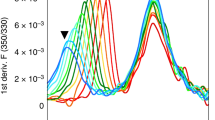Abstract
We used binding of a fluorescent adduct of β2-microglobulin, fluorescein β2m, to probe the stability of class I HLA molecules on the surface of human cells. The weight of the literature suggests that this ligand binds to heavy chains that have lost β2m and possibly peptide as well. Hence Fl-β2m reports on the stability of the class I HLA trimer. A small fraction of HLA molecules, ∼5%, binds Fl-β2m on both resting and activated T cells. A larger fraction of all HLA molecules binds Fl-β2m in FO-1 cells, β2m-deficient cells, transfected with various B2m genes. HLA molecules of FO-1 cells are more stable when expressed with human β2m, than when expressed with mouse β2m. The non-covalent association of HLA heavy chains, β2m and peptide implies that eventually every molecule of HLA trimer ought to dissociate and bind Fl-β2m. In fact, the extent of exchange is limited by the lifetime of a given molecule at the cell surface. β2m exchange decreases as cell concentration increases, suggesting that some density-dependent process acts to enhance degradation or denaturation of β2m-free HLA heavy chains.
Similar content being viewed by others
Author information
Authors and Affiliations
Rights and permissions
About this article
Cite this article
Edidin, M., Achilles, S., Zeff, R. et al. Probing the stability of class I major histocompatibility complex (MHC) molecules on the surface of human cells. Immunogenetics 46, 41–45 (1997). https://doi.org/10.1007/s002510050240
Issue Date:
DOI: https://doi.org/10.1007/s002510050240



